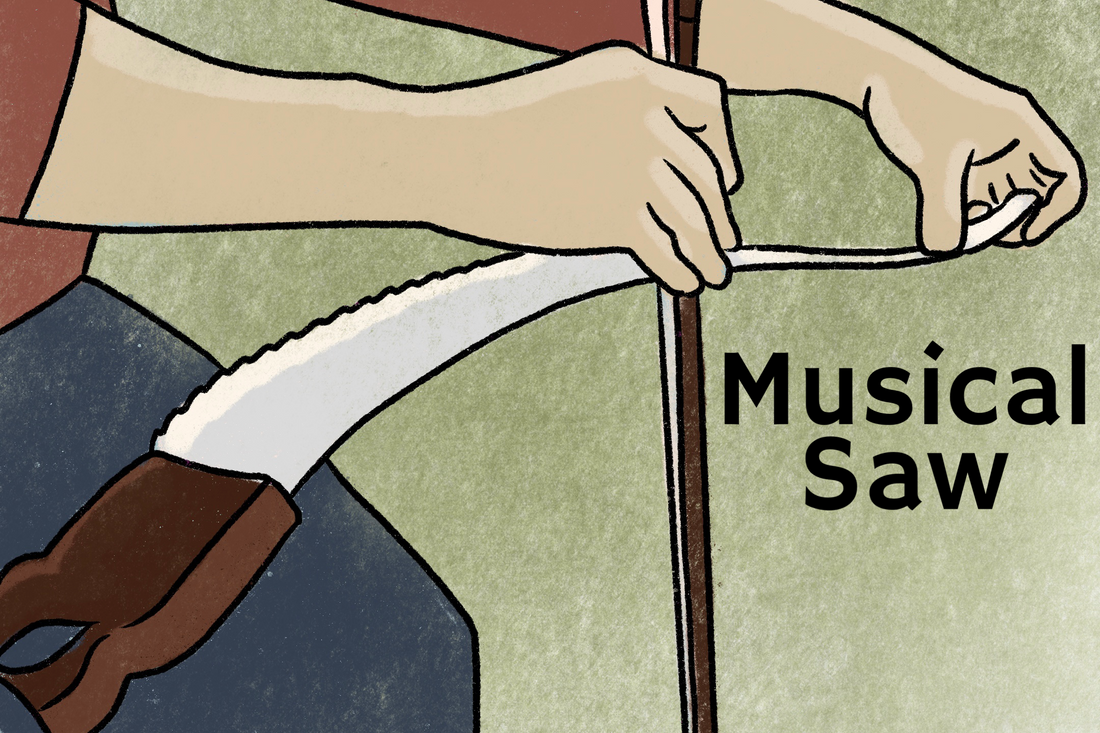For as long as lumberjacks have been cutting trees with commercially available steel saws, people have been using the saw to make music. Despite its humble origins and mundane appearance, the musical saw is capable of producing a haunting and ethereal resonance, resembling the voice of a soprano. The musical saw has been played in a variety of contexts, from church services to vaudeville performances. The instrument fell out of favor during World War II, when steel saw manufacturing slowed down with metals going towards ammunition (More on this here). Today, the musical saw is making a come-back in both modern and classical genres.
HOW MUSICAL SAWS WORK
The musical saw is a type of plaque friction idiophone, played using the direct friction of a bow. This means that the instrument creates sound through vibration, and once bowed, the saw blade can be manipulated to change pitch, such that more than one note can be produced per bow stroke. Any non-electric and full-bladed saw is capable of producing music in this way, although musical saws are made with a blade that is easier to manipulate; they tend to be at least 28 inches in length and are constructed of higher quality steel. Importantly, in order to create a sweet spot for playing the musical saw, there must be an S-curve (inflection point) on the blade, allowing for what physicists refer to as localized vibrational modes (Read more on this here and here). Without an S-curve, you'll have only a dull and short-lived sound, instead of a singing blade.
HOW TO PLAY THE SAW
Musical saws work best when they are rust-free, so either purchase a new saw (such as the Stradivarius Musical Saw) or make sure it is in good condition before attempting to play. Any kind of bow will work, although thicker ones are sometimes a bit easier to use. You'll want to rosin the bow generously, just as you would when playing on a stringed instrument. This will help you to achieve a nice tone as you play.
To set up, you'll place the handle of the saw between your knees and lock it firmly in place, with the serrated edge facing you (of course, it goes without saying that you should avoid cutting yourself on the sharp ends of the saw; many musical saws are designed for safer playing, with dull edges). Hold the tip of the blade with your non-dominant hand and a bow in your dominant hand. When ready to play, press down on the top of the blade with the thumb (bending the saw edge into an arc), then pull with the other fingers upward to curve the blade into a gentle S-shape. Before delving into bowing technique, try hitting the edge of the blade percussively with the bow and listening as the pitch changes at different points and using different curvatures of the blade (Learn more here). After some practice, you'll begin to get a sense for which motions will bend the pitch higher or lower.
When you're ready to start bowing, practice repeatedly pulling the bow upwards, perpendicular the blunt edge of the saw (Remember: not the serrated edge on the side facing towards you, but the flat side). See how much pressure it requires to create a clear tone – and get used to finding this sweet spot. Once you are able to achieve a sound with the bow, see what it sounds like to bow across different points of the saw, moving the blade into different curvatures, and play around with different bowing directions. This will keep you busy for a while!
If you want some additional instruction, we offer musical saws in our shop, as well as instructional DVDs. You can browse our selection online, or view our starter kit here: https://larkinthemorning.com/products/saw001pk
Some Recordings Featuring the Musical Saw:
- Marlene Dietrich radio recording
- Brigid Kaelin plays "My Old Kentucky Home"
- Natalia 'Saw Lady' Paruz plays Chopin Nocturne
- Adriano Fernandez plays "Misty"
- Grégoire Blanc theremin and saw duet
And Some Fun Electronic Effects:


1 comment
Add to your list -
Caroline McCaskey, local Bay Area musician and 2-time International Musical Saw champion, played the National Anthem on Musical Saw for the Oakland Athletics:
https://youtu.be/gfxxi1xqBtY